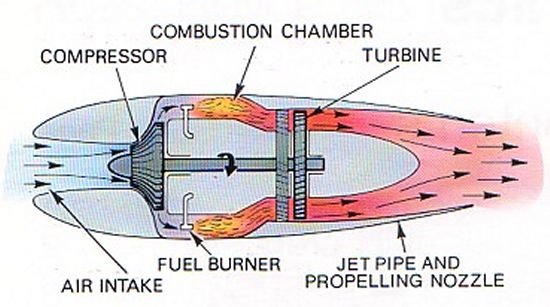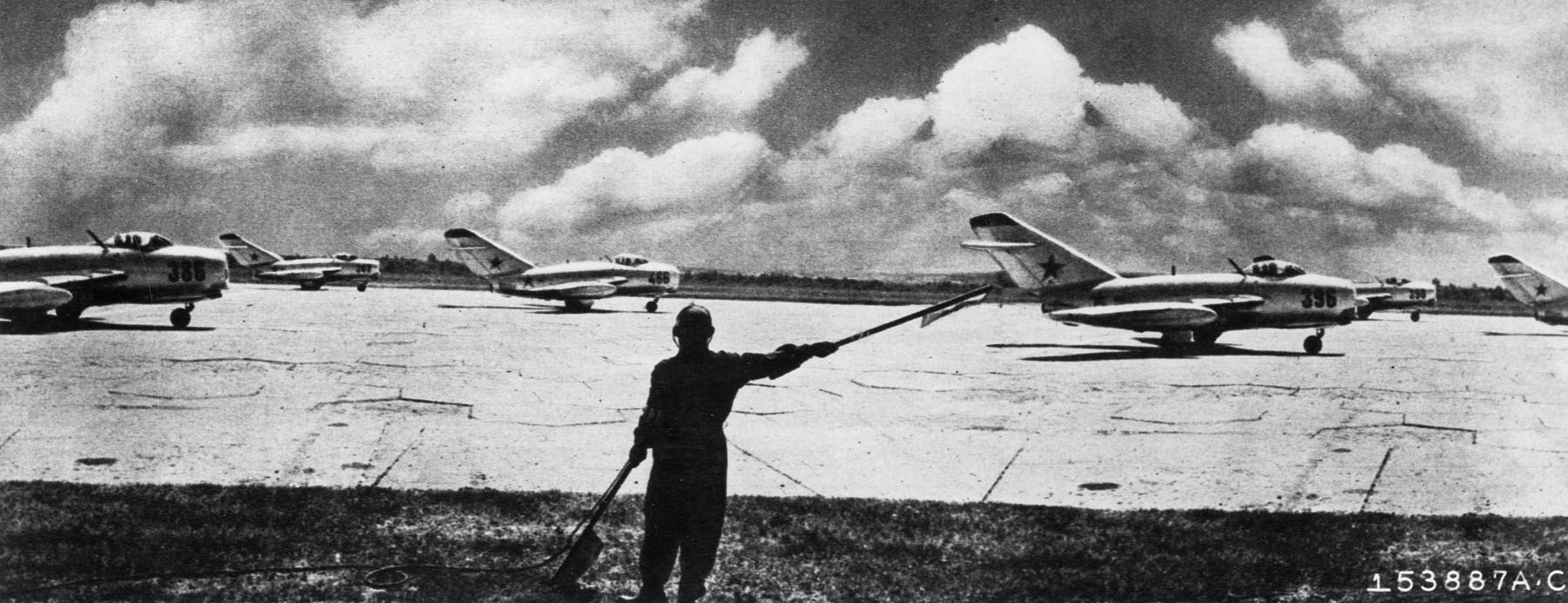Defining Feature of this Generation: Jet Engines
To understand the reasons behind the revolutionary new aircraft, we must first understand how a jet engine allows higher speeds. Until 1938, all aircraft had been propelled by internal combustion engines driving propellers. Propellers are fine for normal aircraft, but people wanted to go higher and faster. To go faster, you could just spin the propeller faster. But eventually a limit is reached where either the propeller disintegrates from spinning too fast, or the blades go supersonic, creating a huge amount of noise and vibration, breaking the propeller (again) or shredding the gearbox. Instead of spinning a big propeller on the nose of the aircraft, jets spin a small propeller inside the engine. Okay, I'll admit it's not that simple. So here's a picture so I don't have to write an essay describing how jets work.
 |
| A simple centrifugal-flow engine, as used in many early jests, including the MiG-15 and Vampire |
Basically, the exhaust velocity was much higher than that of a propeller, allowing for higher speeds.
The Aircraft
Suddenly, aircraft designers no longer had to fit huge V-12 and radial engines in their aircraft, instead only needing the rear fuselage or wings to mount the small turbojets. This left the rest of the aircraft free for aerodynamic improvement and better weapon mounting.
The US developed many jet fighters in the late 40's, testing out new ideas, techniques, and tactics. The only one of these that was built in great numbers was the famous F-86 Sabre. Armed with a battery of six tried and true .50 caliber machine guns, the bright, shiny aluminium Sabre is still the image of early American jet power.
 |
| Sabres on the ground in Korea |
 |
| An elegant aircraft, from a more civilized time |
 |
 |
| nyoooom |
The United Kingdom did not want to fall behind. After all, they were the second country to field a jet fighter. The de Havilland works took input from the RAF and the Fleet Air Arm and designed the Vampire and Sea Vampire (a carrier modification of the original). Armed with four reliable 20mm Hispano Mk. V autocannon, the twin-boom Vampire served most prominently in West Germany as an interceptor.
 |
| A flight of RAF Vampires over Egypt, 1952 |
The RAF was satisfied with the Vampire, but by 1953 it was becoming obsolete. Rolls-Royce had just finished development of its powerful new Avon engine, and it was decided that Hawker would design a new air-frame around the engine. Thus, the Hunter was born. It was fast. Like, 1953 world speed record fast. Armed with four 30mm ADEN autocannon, it was a force to be reckoned with on both sides of the the iron curtain.
The first generation slowly ended with the introduction of the air-to-air missile. Suddenly, engagements could be had outside of visual range. This caused an abrupt switch in aircraft design, going from a focus on maneuverability to a focus on pure speed. Some late first-gen jets such as the Hunter and the F-89 Scorpion were upgraded and armed with air-to-air missiles, but proved no match for the supersonic missile-carrying jets of the future. This marks the point where the complexity of aircraft started to rise exponentially, integrating radar, infra-red, fly-by-wire, and much more into the aircraft to make it the ultimate plane-killer.
 |
| An F-89 Scorpion with six GAR-1/2 Falcon infrared homing missiles on the wingtip pods. |

1 comment:
Very interesting analysis, and a comprehensive breakdown of the advancement of jet technology. I have to wonder why anyone thought a nuclear rocket was a good idea, though, seeing as the Davy Crockett proved to be an equally questionable development.
Post a Comment